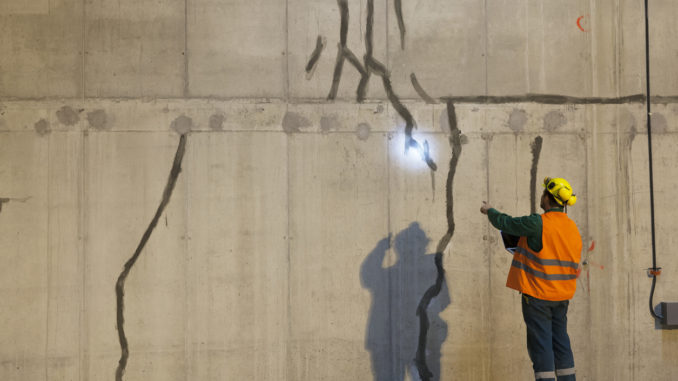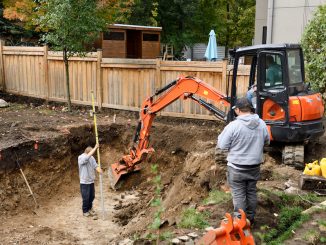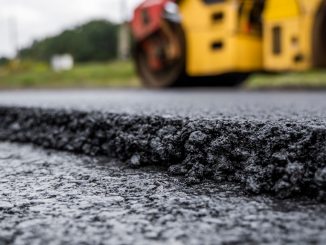
In this section, we are going to discuss the details of preventable early-age cracks. Understanding the timing, cause, and effects of these factors can help with identifying the problems and adjusting mixture and placement techniques to prevent these issues going forward.
Plastic Shrinkage Cracks
These cracks are usually between one and three feet apart, with a length of a few inches up to several feet. The crack depth is shallow, and there is often a perpendicular wind direction. Even though the cracks can occur throughout the panel surface, they don’t often intersect the perimeter of the slab.
- Occurrence Time: The cracks show up while the concrete is in the plastic stage, before it sets.
- Cause: When the surface of the concrete dries too quickly. Usually, weather conditions play a role, such as low humidity during the placement period, high air temperatures, wind, or sudden changes in temperature. Aggregate can also play a role if the sand is too fine or gap-graded aggregate is used (it requires more paste). Additionally, delayed curing application can also increase the risk of plastic shrinkage cracks.
- Effect: Even though they are unsightly, these cracks don’t usually pose a structural problem. But, long-term durability might be an issue since water and chemicals can seep into the cracks.
- Prevention: The key is to observe weather patterns and plan placement times to avoid conditions that might cause shrinkage. Also, use adequate curing techniques at an earlier stage. For hot outdoor temperatures, cool the concrete mixture. Specific subgrade and evaporation-retarding materials can be used. When the concrete is still plastic, revibrating the concrete might be a solution to repair the cracks.
Map Cracking
If the cracks have an appearance of a network of fine fissures, then it is known as a map cracking pattern. Usually, the enclosed areas are irregular and small hexagonal shapes. The cracks are shallow, usually less than 3 mm deep.
- Occurrence Time: These cracks are usually apparent within the first one to seven days after placement
- Cause: Hand pours that with inadequate curing or excessive over finishing are at risk for map cracking. Mixes that are too wet also have a higher risk of cracking. Another cause is when water is sprayed on the surface of the concrete to facilitate finishing.
- Effect: Sometimes the cracks aren’t visible on dry pavement, but the cracking patterns show up when it is wet. Even though the appearance is unsightly, it doesn’t cause issues with the structure of the pavement. But, these small cracks might bring in chemicals and water, which can lead to long-term durability issues.
- Prevention: Always avoid spraying the concrete with water. If bleed water is present, then the surface should not be finished in these conditions. Don’t sprinkle dry cement if the surface has bleed water. Be efficient with the finishing to avoid overworking the concrete. Curing should always be done as soon as possible, and you might consider wet curing methods such as wet burlap or fog spraying.
- Repair: These cracks usually don’t require repair since the structure of the concrete is sound. The appearance can be improved with a diamond grinding surface treatment.
Random Transverse Cracks (Drying Shrinkage Cracks)
Look for cracks that are perpendicular to the centerline, often with a “Y” shape fork in the cracking pattern. Sometimes, the random transverse cracks are long enough to reach to the edge of the pavement. The crack extension is usually as deep as the slab and might be hairline or open.
- Occurrence Time: Typically, random transverse cracks show up within the first 72 hours. You will notice the cracks after the concrete has set, but before the area is opened to traffic.
- Cause: This problem happens when the concrete sets before enough strength is gained to resist tensile stresses such as warping, curling, and cumulative shrinkage. Various factors might increase the risk, such as premature drying, high setting temperature, dry aggregate, changes in weather and temperature patterns, and using high shrinkage mixes
- Effect: Most concrete pavements are designed to be jointed pavements with no continuous reinforcements. If these cracks are present, then they allow chemicals and water to enter the concrete, leading to durability concerns. Certain types of transverse cracks that are “not working” can result in failure of the structure. If the cracks occur on unjointed concrete with continuous reinforcement, then there are no concerns. The reinforcements ensure that the cracks happen at an acceptable spacing and the cracks will be held together, which helps to prevent the infiltration of water and other damaging fluids.
- Prevention: Select a mix with low paste content to reduce the risk of dry shrinkage. Whenever possible, maximize the amount and size of coarse aggregate. The grade should be wet before paving. Use pre-cooled materials in the mixture and control the heat of hydration by minimizing the temperature needed for the concrete to set. Proper placing and timing of the joints are also important. Avoid drastic temperature changes and avoid traffic on the concrete as long as possible so that the proper strength can be developed.
- Repair: When the cracks are “not working” and there is no detectable displacement or vertical movement, then the cracks simply need to be sawed and sealed. If the cracks are “working” or near a joint, then it usually requires a full-depth repair to avoid structural failure in the future.
Random Longitudinal Cracks
These cracks develop in a pattern parallel to the centerline and typically run the entire length of the slab. They can be invisible hairline cracks or open patterns.
Note: For random longitudinal cracks, you should follow the same recommendations that were provided above for random transverse cracks. But, there are a few additional details that need to be considered:
- Occurrence Time: These cracks can appear within the first 24 hours. Or, sometimes the cracks don’t appear for several months.
- Cause: Avoid problems with nonuniform base support, such as expansive soils, frost heaving, or soil setting. Joints that are too far apart can increase the risk of these cracks. Additionally, joints that are cut too shallow can cause random longitudinal cracks.
- Control: When unreinforced concrete is placed with more than one lane width at a time, then longitudinal joints should be formed or cut where the cracks would appear.
- Prevention: Ensure the stability of the base before concrete placement. Keep construction traffic off the slab after placement, especially near the slab edges. Avoid placement in extreme temperatures. Don’t tie too many lanes together with tiebars. Slabs that are 10 in (25 cm) thick or more should be no wider than 14 or 15 ft (4 m) without a longitudinal joint. Slabs that are 9 in (23 cm) thick or less should be no wider than 12 ft (3.5 m) wide without a longitudinal joint.
Corner Breaks
When the cracks are at a 45-degree angle and intersecting the adjacent transverse and longitudinal joints, then they are known as corner breaks. These cracks have full depth, and they can be between one foot and the full half of the slab.
- Occurrence Time: Corner breaks will appear after a set but before the pavement is opened to the public. The cracks can continue formation for years, usually when the support is lost due to warping and curling, expansive soils, frost heaving, erosion, and soil settling.
- Cause: If there is a loss of base support or the pavement carries loads that are too heavy for the strength, then these cracks will form. A common cause is early loading using heavy construction equipment. When reduced support is present, the slab lifts from the grade and the pavement will crack under the load. A lack of uniformity in the base means that the slab will lose support.
- Effect: The presence of these cracks is a good indication of structural failures.
- Prevention: Ensure uniformity of the base. Keep construction traffic off the slabs as long as possible. Use proper curing techniques to reduce warping and curling.
- Repair: Full depth repair is usually required. Additionally, stabilization of the base needs to be addressed.
-
Why does concrete develop plastic shrinkage cracks, and what preventive measures can be taken?
Plastic shrinkage cracks occur when the concrete surface dries too quickly due to factors like low humidity or high temperatures; prevention involves observing weather conditions, using adequate curing techniques, and adjusting the concrete mixture.
How can random transverse cracks in concrete pavements be prevented, and what measures should be taken if these cracks are detected?
To prevent random transverse cracks, choose a mix with low paste content, maximize coarse aggregate, control temperature, and implement proper joint placement; if detected, non-displaced cracks may only need sawing and sealing, while working cracks near joints may require full-depth repairs












































